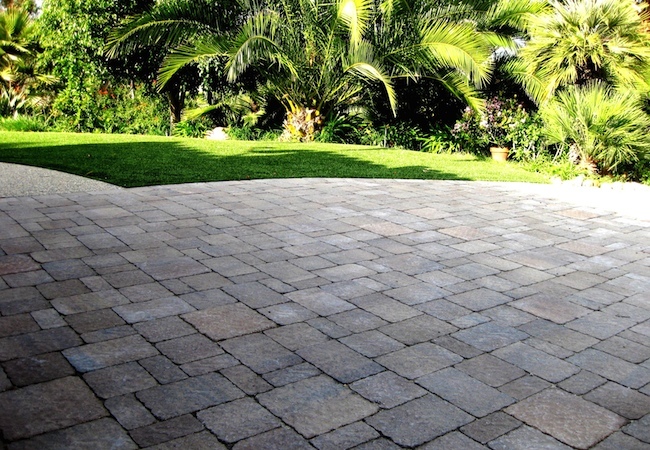

We may earn revenue from the products available on this page and participate in affiliate programs. Learn More ›
Pavers are a versatile, DIY-friendly, landscaping material that can be used for laying paths, steps, driveways, pool surrounds, and patios around your yard. Pavers have been used for thousands of years to improve comfort when walking outside of homes and for creating places in which friends and family can gather.
Types of Patio Pavers
Pavers are typically made from concrete, clay, and stone. They can also be made from recycled materials (in which case they are known as composite pavers).
- Concrete pavers can be dyed to almost any color. In addition to looking like concrete, they can be molded to look like clay bricks, cobblestone, flagstone—you name it. The shapes are usually rectangular, but other shapes, including hexagons, interlocking, and irregular shapes are available. A nice feature with many concrete pavers is the molded-in spacers that make laying them easier.
- Stone pavers are quarried and cut to standard sizes and thicknesses. They are made from marble, travertine, limestone, granite, bluestone, and many other stone varieties. Colors are naturally earthen but do range from light to dark, including yellow rose, blue gray, and more. While real stone pavers are generally more expensive than concrete lookalikes, there’s no mistaking the authenticity once you see the finished job. In addition, stone is available in larger formats than concrete and in many finishes. The more textured finishes are recommended for outdoor use to help prevent slipping when the surface is wet. They include tumbled, saw cut, acid-etched, bush-hammered, and flamed finishes.
- Composite pavers are made from used plastics and scrap tires and release less carbon and use less energy in their manufacture than concrete and brick, according to Vast Enterprises. The shapes are typically brick-like and are set upon a modular plastic grid. In addition, composite pavers are light, only nine pounds per square foot, versus about 30 pounds per square foot for concrete pavers. Their weight makes them especially suitable for green roofs and for resurfacing wood decks. Composite pavers cut easily with circular saws of various types.
Patterns and layouts
Pavers can be laid in any number of patterns and layouts, including rectangular and curved. The latter will require more cutting and fitting but is well within the capabilities of a homeowner with a heavy-duty circular saw that’s fitted with a diamond masonry-cutting disk. For larger patios, consider renting a table-style brick saw. Brick and brick-shaped concrete pavers can be arranged to create many patterns, including herringbone, basket weave, running bond, and stacked bond. In recent years, concrete paver combinations of varying sizes, colors, and textures have been used to create more complex patterns.
Installation
Pavers may be laid upon a concrete slab, bedded in mortar, or dry-laid on a prepared base of gravel and bedding sand. The latter requires the least amount of work and skill and is best suited to the do-it-yourselfer.

Caution
Before any sort of excavation work, check to be sure there are no utility lines—such as gas, water, and electrical lines—buried below. (A nearby lamppost is a good clue!) Also, check for subsurface drainpipes, cisterns, and tanks. A safe way to do this is to call 811 to have your underground utility lines marked for free.
- Every installation begins with laying out the area that’s to be paved and marking it with marking spray. A garden hose may be used to help you envision the contours of curved elements, such as paths and driveways.
- Excavation to accommodate several inches of gravel and sand, and to level the grade if necessary, comes next. Avoid digging down farther than necessary. It’s important to keep the subsoil undisturbed and stable to prevent depressions from forming later.
- Next, the excavated surface is leveled and a landscape fabric is laid in place for weed prevention.
- Then comes a three- or four-inch layer of gravel, compaction, and more leveling. (Compaction, either with a manual tamper or gasoline-powered compactor is critical.)
- After that comes a one-inch layer of bedding sand or stone dust, more compaction, and leveling.
- String lines (mason twine run from wood stakes) help guide the placement and setting depth of pavers. (Dry-laid paths and patios may be edged with staked-in boards, metal strips, or with brick set in a two-inch-deep bed of mortar. Edging is important, because it keeps the pavers from shifting.)
- Fine masonry sand is swept into the joints to lock the pavers in place. (Use polymeric sand, if you don’t want to have to renew joint sand in the future. It contains a bonding agent that helps to keep the sand from getting washed away during rainstorms.)
- Follow with a spray of water to settle the sand; add more as necessary.
